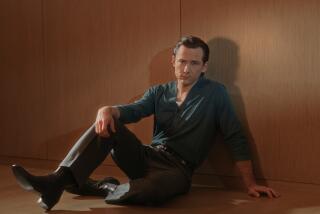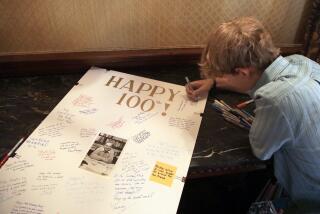85 and Going Strong, Pauling Hears the Cheers
- Share via
When he was 21, Linus Pauling entered Caltech where he would spend 42 birthdays before saying goodby, still stepping off to the music of a different drummer.
When he returned to Pasadena last week, it was to celebrate his 85th birthday and to hear himself hailed as the greatest chemist of the 20th Century, one of the greatest scientists in the world and the only person ever to be awarded two unshared Nobel Prizes, and really deserving a third.
At his 85th birthday celebration last week, Pauling was called “the true father of molecular biology,” “the man most responsible for the nuclear test ban treaty,” “an enormously effective lecturer with a seraphic smile” and “a slightly enigmatic genius.”
Pauling, as noted for his self-confidence and humor as his genius, replied that:”It’s been a great experience, hearing all these talks today. I could probably have talked about myself more effectively and better.”
Academic Holiday Declared
The seraphic smile never waned, only widened after the daylong tribute that filled Beckman Auditorium and the Athenaeum with scientists, students, family and old friends.
Caltech declared an academic holiday for the event that was staged by its Division of Chemistry and Chemical Engineering and headed by chemistry professor Ahmed Zewail. Most of the speakers were fellow scientists who expanded on Pauling’s historic findings in chemical bonding, the structures of molecules, antibodies and the structure of proteins. His book, “The Nature of the Chemical Bond,” was the masterwork that won him the Nobel Prize in science in 1954.
Other speakers referred to Pauling’s efforts toward world peace and against nuclear arms, which pitted him against anti-Communist forces in Congress but won him the Nobel Peace Prize in 1962. Pauling left Caltech two years later, having been demoted by Caltech trustees who were sensitive to the glaring publicity he attracted. He had been removed as chairman of chemistry and director of two labs.
Speakers made only fleeting references to Pauling’s latest, and most controversial, work in which he claims that large doses of vitamin C prevent a variety of illnesses, including cancer.
In a brief talk that was riddled with inside scientific jokes far beyond a layman’s comprehension, Pauling said, “Of all the places in the world I might have gone to, Caltech gave me the best education, the best preparation for the work I was to do. The Caltech years were the greatest in my life.”
Then he bounded down a flight of stairs from the Beckman stage, up the aisle, and into eager arms.
Among those who greeted and paid tribute to him were Nobel winners Francis Crick of the Salk Institute in La Jolla, Henry Taube of Stanford and Willy Fowler, a physicist who in 1983 became Caltech’s 20th and most recent Nobel laureate.
Pauling was hugged, patted, followed and adored all day. In a scene reminiscent of 1960s peace marches when he was frequently pictured in eccentric clothes and settings, Pauling happily posed with a pretty girl kissing him.
Recalling their work together, Norman Davidson, Caltech’s Norman Chandler professor of chemical biology, said Pauling was “the leading chemist in the 1930s, enough to entitle him to a Nobel prize then, but the committee was timid.
‘Don’t Say It’s Crazy’
Davidson, a Pauling associate for almost 20 years, added, “If Linus Pauling has an idea, it’s audacious, but don’t say it’s crazy. All his ideas are interesting; they don’t all turn out to be right.”
The tributes came from a variety of sources . . .
- Caltech President Marvin Goldberger called Pauling “vibrant--sometimes overly resonant--in chemistry.”
- Ken Trubler, a Pauling student who became professor of chemistry at UCLA, called the guest of honor “one of a handful of men who made Caltech what it is today.”
- B. B. Sharma, another former student and professor of chemistry at Pierce College and Cal State Los Angeles, said Pauling’s mind “is doing more today than the minds of brilliant men who are many years younger.”
- Geoffrey Dolbear of Diamond Bar took a day off from his work as a chemical engineer in Brea and came bearing his old college text from 1961--”The Nature of Chemical Bonds”--for Pauling’s autograph. “This is the book that tied it all together,” Dolbear said.
- Linus Kamb, 21, an architecture student at the University of California, Berkeley, said, “I knew he was famous and all, but to me he’s been just my grandfather and I always loved being with him.”
Three Caltech doctoral candidates in chemistry, Larry Peng of St. Louis, Marcos Dantus of Mexico and Isaac Xavier of Brazil, kept pace with Pauling all day and vowed to take vitamin C in order to match their hero’s energy.
‘Some Kind of Dream’
Xavier said he bought a Portuguese translation of “The Nature of Chemical Bonds” when he was “just a kid in Brazil, just for the excitement of reading it. To me, it’s some kind of dream, meeting Linus Pauling.”
Several autograph seekers clutched copies of Pauling’s latest book, “How to Live Longer and Feel Better,” written in his home in Big Sur and published last month.
In a talk titled “Life with Linus,” Edward Hughes, Caltech senior research associate emeritus in chemistry, said Pauling predicted at his last Caltech birthday party in 1975 that his next official celebration would be in 1991, when he will be 90.
“That’s his first serious error in prediction,” Hughes said. “It came five years early. Everyone is invited back on Feb. 28, 1991.”






